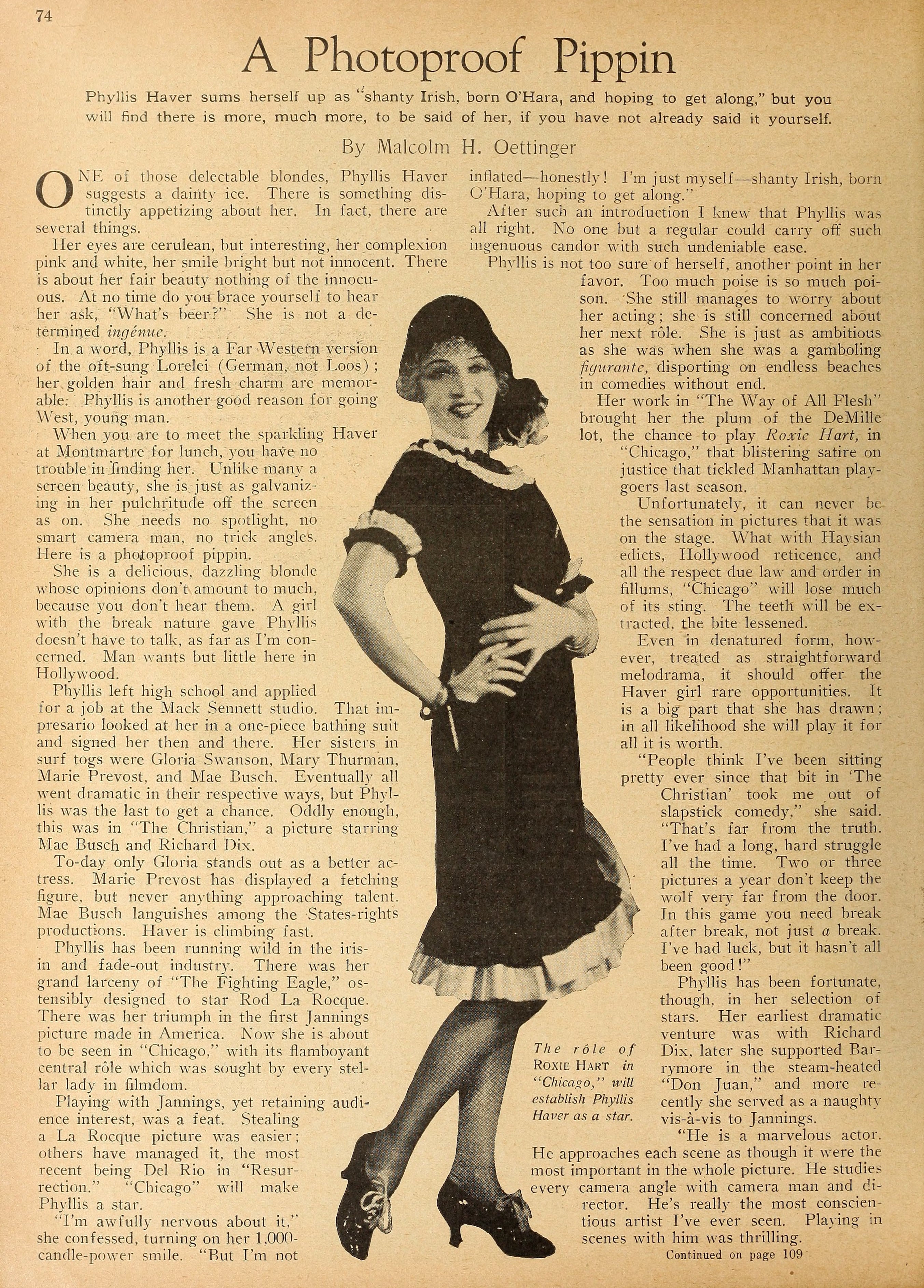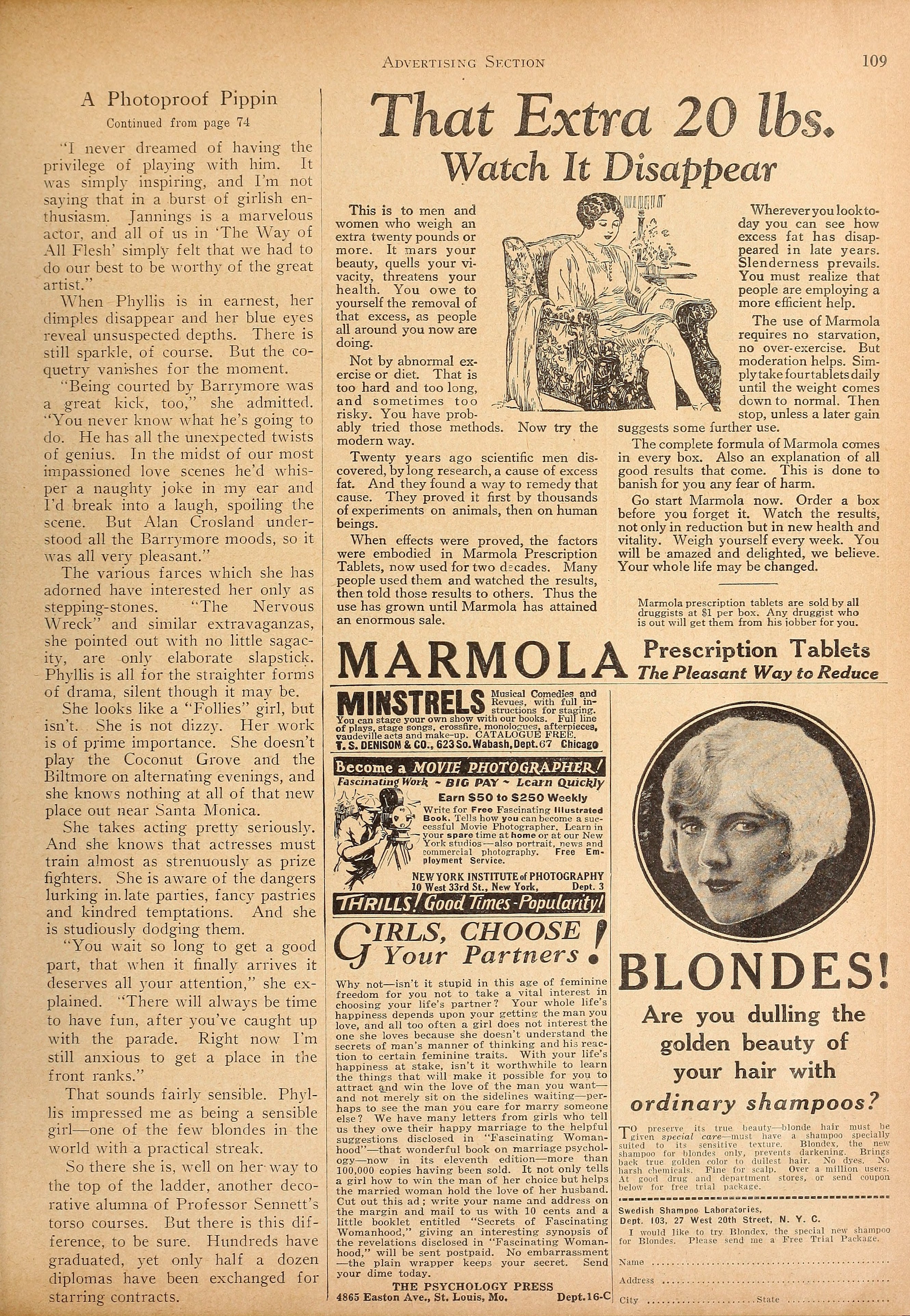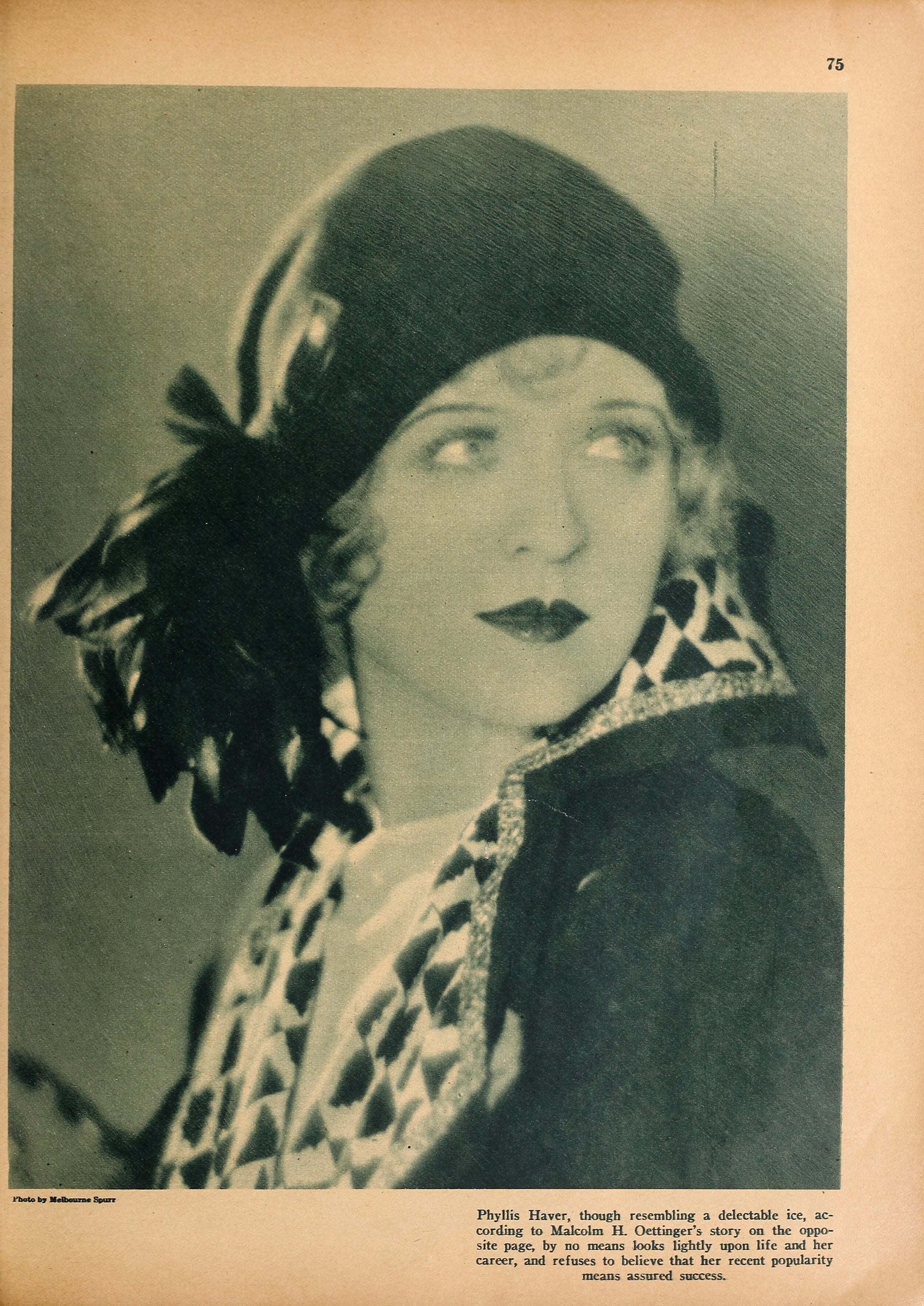Phyllis Haver — A Photoproof Pippin (1928) 🇺🇸

One of those delectable blondes, Phyllis Haver suggests a dainty ice. There is something distinctly appetizing about her. In fact, there are several things.
by Malcolm H. Oettinger
Her eyes are cerulean, but interesting, her complexion pink and white, her smile bright but not innocent. There is about her fair beauty nothing of the innocuous. At no time do you brace yourself to hear her ask, “What’s beer?” She is not a determined ingénue.
In a word, Phyllis is a Far Western version of the oft-sung Lorelei (German, not Loos); her, golden hair and fresh charm are memorable: Phyllis is another good reason for going West, young man.
When you. are to meet the sparkling Haver at Montmartre for lunch, you have no trouble in finding her. Unlike many a screen beauty, she is just as galvanizing in her pulchritude off the screen as on. She needs no spotlight, no smart camera man, no trick angles. Here is a photoproof pippin.
She is a delicious, dazzling blonde whose opinions don’t amount to much, because you don’t hear them. A girl with the break nature gave Phyllis doesn’t have to talk, as far as I’m concerned. Man wants but little here in Hollywood.
Phyllis left high school and applied for a job at the Mack Sennett studio. That impresario looked at her in a one-piece bathing suit and signed her then and there. Pier sisters in surf togs were Gloria Swanson, Mary Thurman, Marie Prevost, and Mae Busch. Eventually all went dramatic in their respective ways, but Phyllis was the last to get a chance. Oddly enough, this was in “The Christian,” a picture starring Mae Busch and Richard Dix.
To-day only Gloria stands out as a better actress. Marie Prevost has displayed a fetching figure, but never anything approaching talent. Mae Busch languishes among the States-rights productions. Haver is climbing fast.
Phyllis has been running wild in the iris-in and fade-out industry. There was her grand larceny of “The Fighting Eagle,” ostensibly designed to star Rod La Rocque. There was her triumph in the first Jannings [Emil Jannings] picture made in America. Now she is about to be seen in “Chicago,” with its flamboyant central role which was sought by every stellar lady in filmdom.
Playing with Jannings, yet retaining audience interest, was a feat. Stealing a La Rocque picture was easier; others have managed it, the most recent being Del Rio [Dolores Del Río] in Resurrection. Chicago will make Phyllis a star.
“I’m awfully nervous about it,” she confessed, turning on her 1,000-candle-power smile. “But I’m not inflated — honestly! I’m just myself — shanty Irish, born O’Hara, hoping to get along.”
After such an introduction I knew that Phyllis was all right. No one but a regular could carry off such ingenuous candor with such undeniable ease.
Phyllis is not too sure of herself, another point in her favor. Too much poise is so much poison. ‘She still manages to worry about her acting; she is still concerned about her next role. She is just as ambitious as she was when she was a gamboling figurante, disporting on endless beaches in comedies without end.
Her work in “The Way of All Flesh” brought her the plum of the DeMille lot, the chance to play Roxie Hart, in Chicago, that blistering satire on justice that tickled Manhattan playgoers last season.
Unfortunately, it can never be the sensation in pictures that it was on the stage. What with Haysian edicts, Hollywood reticence, and all the respect due law and order in fillums, Chicago will lose much of its sting. The teeth will be extracted, the bite lessened.
Even in denatured form, however, treated as straightforward melodrama, it should offer the Haver girl rare opportunities. It is a big part that she has drawn; in all likelihood she will play it for all it is worth.
“People think I’ve been sitting pretty ever since that bit in ‘The Christian’ took me out of slapstick comedy,” she said. “That’s far from the truth. I’ve had a long, hard struggle all the time. Two or three pictures a year don’t keep the wolf very far from the door. In this game you need break after break, not just a break. I’ve had luck, but it hasn’t all been good!”
Phyllis has been fortunate, though, in her selection of stars. Her earliest dramatic venture was with Richard Dix, later she supported Barrymore in the steam-heated “Don Juan,” and more recently she served as a naughty vis-à-vis to Jannings.
“He is a marvelous actor. He approaches each scene as though it were the most important in the whole picture. He studies every camera angle with camera man and director. He’s really the most conscientious artist I’ve ever seen. Playing in scenes with him was thrilling.
“I never dreamed of having the privilege of playing with him. It was simply inspiring, and I’m not saying that in a burst of girlish enthusiasm. Jannings is a marvelous actor, and all of us in The Way of All Flesh simply felt that we had to do our best to be worthy of the great artist.”
When Phyllis is in earnest, her dimples disappear and her blue eyes reveal unsuspected depths. There is still sparkle, of course. But the coquetry vanishes for the moment.
“Being courted by Barrymore was a great kick, too,” she admitted. ‘’You never know what he’s going to do. He has all the unexpected twists of genius. In the midst of our most impassioned love scenes he’d whisper a naughty joke in my ear and I’d break into a laugh, spoiling the scene. But Alan Crosland understood all the Barrymore moods, so it was all very pleasant.”
The various farces which she has adorned have interested her only as stepping-stones. The Nervous Wreck and similar extravaganzas, she pointed out with no little sagacity, are only elaborate slapstick. Phyllis is all for the straighter forms of drama, silent though it may be.
She looks like a “Follies” girl, but isn’t. She is not dizzy. Her work is of prime importance. She doesn’t play the Coconut Grove and the Biltmore on alternating evenings, and she knows nothing at all of that new place out near Santa Monica.
She takes acting pretty seriously. And she knows that actresses must train almost as strenuously as prize fighters. She is aware of the dangers lurking in late parties, fancy pastries and kindred temptations. And she is studiously dodging them.
“You wait so long to get a good part, that when it finally arrives it deserves all your attention,” she explained. “There will always be time to have fun, after you’ve caught up with the parade. Right now I’m still anxious to get a place in the front ranks.”
That sounds fairly sensible. Phyllis impressed me as being a sensible girl — one of the few blondes in the world with a practical streak.
So there she is, well on her way to the top of the ladder, another decorative alumna of Professor Sennett’s torso courses. But there is this difference, to be sure. Hundreds have graduated, yet only half a dozen diplomas have been exchanged for starring contracts.

The role of Roxie Hart in Chicago will establish Phyllis Haver as a star.


Phyllis Haver, though resembling a delectable ice, according to Malcolm H. Oettinger’s story on the opposite page, by no means looks lightly upon life and her career, and refuses to believe that her recent popularity means assured success.
Photo by: Melbourne Spurr (1888–1964)
Collection: Picture Play Magazine, March 1928
